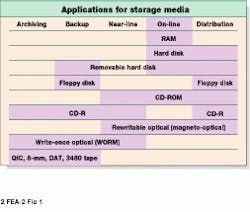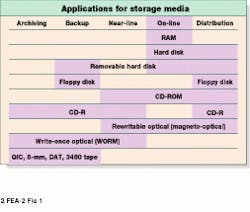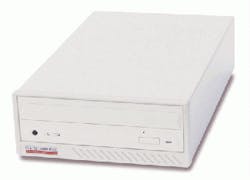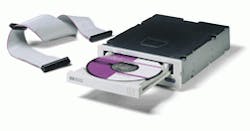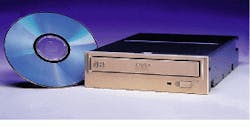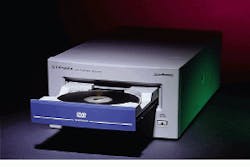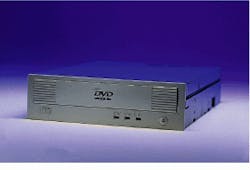DVD technology increases image storage on rewritable media
DVD technology increases image storage on rewritable media
By Andrew Wilson, Editor at Large
In recent years, increases in the processing power of computers and larger amounts of data handled have placed more intensive demands on data-storage systems for image-processing applications. In medical-imaging systems, for example, images of 100 Mbytes are common. In scientific-analysis systems, images might not be as large, but, just as with medical-imaging applications, the requirements to store multiple images still exist.
When images are transmitted, exchanged, or stored, they are sometimes compressed, often in a lossy manner. Moreover, imaging data processing generally implements procedures that are time-consuming and tedious. In addition, the large amounts of imaging data involved also raise the storage costs -- a critical systems-integration factor in the archiving of images that cannot be compressed without loss.
Whereas removable drives address a range of applications, magnetic drives cannot serve the needs of all applications that optical drives can (see Fig. 1). By combining the functions of various storage devices, optical drives perform well over multiple applications.
CD technologies
Although able to store large amounts of data, CD-ROMs allow reading but not writing. In contrast, CD recordable-once (CD-R) and CD rewritable (CD-RW) drives and disks permit image-processing systems to record up to 650 Mbytes of data, or 74 minutes of audio programming. For applications such as data storage, in which small amounts of images need to be archived, CD-R and CD-RW devices provide worthwhile alternative storage media. CD-R media are write-once optical disks that can be recorded but not erased, whereas CD-RW media allow data to be written and rewritten to the compact disk.
For example, four CD-R drives from Synchrome Technology (Santa Cruz, CA) are designed specifically for such imaging applications. Priced at $719 and $620, respectively, the company`s Maestro 4x12E external drive and 4x12I internal drive can write to recordable CDs at up to 4X speed and can read CDs at a 12X rate (see Fig. 2). Both can be connected to a computer via a SCSI interface. The company`s 2x6I and 2x6E models are internal and external versions, respectively, that can record CDs at up to a 2X rate and can read CDs at up to a 6X rate. To ensure upgrade compatibility with the next generation of digital video disks (DVDs), Synchrome supplies system developers with optional packet-writing software that allows CD-R disks to be played on future DVD drives.
Hewlett-Packard (Palo Alto, CA) also offers a CD-R drive, the SureStore CD-WriterPlus, that uses CD-R and CD-RW media. With an IDE interface, the drive plugs into a standard PC parallel port. Available in both 7100I internal and 7100E external versions, the drives are priced at $499 and $610, respectively (see Fig. 3). They also support the company`s multiread capability that ensures compatibility with DVD-R, CD-R, and CD-ROM drives.
Enter DVDs
According to industry experts, digital video disks are expected to serve as the next generation of optical-disk-storage technology. Digital-video-disk technology is essentially a CD-like technology that can hold video, audio, and computer data. "DVD aims to encompass home entertainment, computers, and business information with a single digital format and eventually replace audio CD, videotape, laserdisc, CD-R, and perhaps even video-game cartridges," says Jim Taylor, director of information technology at Video Discovery (Seattle, WA).
"What makes DVD superior to CD," says Rich Dambrise, engineering and technical support manager of Maxell Corp. of America (Santa Fe Springs, CA), "is the manufacturing process and internal design." During manufacture, two injection molders are required to make one DVD, which consists of two bonded 0.6-mm disks. The second manufacturing step is hot-melt-glue bonding (for single-layer disks) or ultraviolet bonding (for dual-layer disks). "For the dual-layer design, a semireflective layer is also added to allow both information layers to be read from one side of the disk," adds Dambrise.
In evaluating overall design, DVD systems possess major advantages over CD-based systems. To improve the resolution and readability of two distinct layers, the minimum pit length of a single-layer DVD is 0.4 mm, less than half the 0.83-mm length for a CD. In addition, the DVD track pitch is reduced to 0.74 mm, again less than half the CD`s 1.6-mm pitch. When these factors are added to more efficient error correction, channel bit modulation, and sector overhead, DVDs provide more than seven times the storage capacity of CDs. Therefore, while standard CDs are capable of storing 650 Mbytes of data, double-sided dual-layer 8-cm DVD disks can hold up to 5.3 Gbytes.
Formats abound
Like CD technology, DVD technology comes in a variety of formats, including DVD-ROM, a format that prevents writing to disk. In another approach, DVD-video technology holds video programs for use with a video player. Other variations include those that record only once (DVD-R) or those that can be recorded many times (DVD-RW, DVD-RAM, and others). There is also a DVD-Audio format, but, according to Video Discovery`s Taylor, the specifications have not yet been determined.
DVD-ROM is a high-throughput, read-only optical disk that is used for general-purpose computer storage. DVD-ROM drives are essentially 8X CD-ROM drives with seven times the storage capacity. These drives are available from several manufacturers, including Toshiba America Information Systems (TAIS; Irvine, CA). The company`s latest DVD-ROM drive, the SD-M1102, costs $279 in quantity and delivers a 2X maximum read of DVD media at 1350 to 2700 kbyte/s and a 24X maximum read of CD media at 1550 to 3600 kbyte/s. The burst data-transfer rate is 16.7 Mbyte/s. Average random-access time is 160 ms for DVD-ROM media and 105 ns for CD-ROM media. The DVD-ROM drive also provides read compatibility with CD-R and CD-RW drives (see Fig. 4).
DVD-R drives are also available--but at a price. "In October last year, Pioneer New Media Technologies announced DVD-R drives for $17,000," Taylor says, "but this price could drop to $5000 within a year. Pioneer`s DVR-1015, the industry`s first DVD-R drive, offers a 3.9-Gbyte capacity, about six times more storage than that of a CD-R disk (see Fig. 5). At present, the initial price for DVD-R media is about $30 for single-sided and $45 for double-sided. "Disk prices for both DVD-R and DVD-RAM will drop quickly, but DVD-R disks will probably be cheaper in the long run," notes Taylor.
Two choices
Selecting a rewritable DVD is a complex chore. At present, two competing technologies exist, DVD+RW and DVD-RAM, with more expected next year. The DVD+RW technology uses a 12-cm disk that contains an initial capacity of 3 Gbytes and is based on a phase-change rewritable format adopted by Hewlett-Packard, Philips Electronics (New York, NY), Sony Electronics (San Jose, CA), Mitsubishi (Tokyo, Japan), Ricoh (Sparks, NV), and Yamaha Corp. (Buena Park, CA).
Although DVD-RAM technology also uses phase-change technology, defect-management techniques and media-reflectivity differences make it incompatible with DVD-RW, and vice-versa. This month, Toshiba America is shipping its first DVD-RAM drives, the SD-W1001 and the SD-W1002, which are available to OEMs and systems integrators.
Providing capacities of 2.6 Gbytes (single-sided disks) to 5.2 Gbytes (double-sided disks), the drives also furnish transfer rates from DVD-RAM media at 1.352 Mbit/s, DVD-ROM media at up to 1.487 Mbit/s, and CD media at 2.4 Mbit/s. While the SD-W1002 supports burst transfers of data in SCSI synchronous mode, the SD-W1002 supports 16.7-Mbit/s transfers in DMA multiword Mode-2 and PIO Mode 4. Both drives provide a 150-ms average random-access time when reading DVD media, and both are priced at $799 (see Fig. 6).
"By eliminating the need for a caddy, ensuring CD-R compatibility, and offering a slightly higher capacity," says David Bunzel, managing director of Santa Clara Consulting (Santa Clara, CA), "DVD+RW offers a compelling alternative to DVD-RAM. Indeed, the participants in DVD-RW represent more than three-quarters of the CD R/RW writer business," he adds. And it may be this fact, more than any other, that determines which technology will become the de facto standard.
And more differences
In addition to the two leading incompatible formats, other manufacturers have also developed still other formats. This month, NEC (Tokyo, Japan) is proposing a DVD format dubbed the multimedia video format (MMVF). According to Hiromichi Fukuchi, general manager of optical recording at NEC`s Technology Development Center, the new format is equally suited to video and data storage and allows 5.2 Gbytes to be stored on a single-sided disk.
Fukuchi says that NEC had attempted to propose the technology to the DVD Forum but, because the company was not a member of the group, NEC found it difficult to present the idea. The MMVF system uses a different type of laser-modulation method than that of DVD-RAM to store higher data rates.
According to Video Discovery`s Taylor, other formats include DVD-ER, a phase-change-based erasable format from Pioneer, that will probably feature a 3.95-Gbyte capacity and an advanced storage magneto-optical format, formerly known as MO7, which is being developed by a consortium including Fujitsu, Mitsubishi, Matsushita, and LG.
Just as DVD vendors strive to increase data capacity and transfer rates of optical media, the lack of industry standards continues to plague the rewritable optical industry. This year, however, the battle between DVD-RW, DVD-RAM, and other rewritable standards will come to the forefront, with Sony expected to ship its DVD-RW drives and media this summer. According to the company, DVD-RAM will compete with DVD-RW and provide 3 Gbytes of storage on a 12-cm-disk form factor. After the dust clears and a worldwide standard emerges, systems integrators tasked with storing massive amounts of data will benefit immensely. Until then, though, they probably should move cautiously in implementing DVD technology.
FIGURE 1. Imaging applications for storage media encompass a range of technologies. Noticeably, optical memory technology encompasses the widest storage range.
FIGURE 2. Synchrome Technology`s Maestro 4x12I internal drive (top) and 4x12E external drive (bottom) can write to recordable compact disks at up to 4X speed and read them at a 12X rate.
FIGURE 3. Hewlett-Packard`s CD-R drive, the SureStore CD-WriterPlus, is available in 7100I internal and 7100E external versions, priced at $499 and $610, respectively.
FIGURE 4. Toshiba America Information Systems` DVD-ROM drive, the SD-M1102, delivers a 2X maximum read of DVD media at 1350 to 2700 kbytes/s and a 24X maximum read of CD media at 1550 to 3600 kbytes/s. The drive also provides read compatibility with CD-R and CD-RW drives.
FIGURE 5. Last year, the Pioneer DVD-R drives cost $17,000. The price is expected to drop to $5000 sometime this year.
FIFIGURE 6. Toshiba America`s DVD-RAM drives, the SD-W1001 and SD-W1002, provide storage capacities of 2.6 to 5.2 Gbytes and transfer rates from DVD-RAM media at 1.352 Mbit/s.
